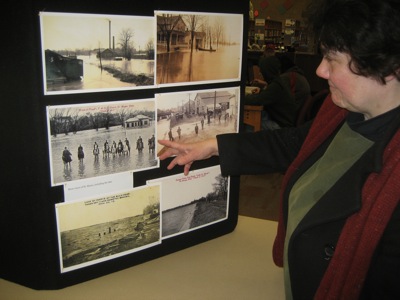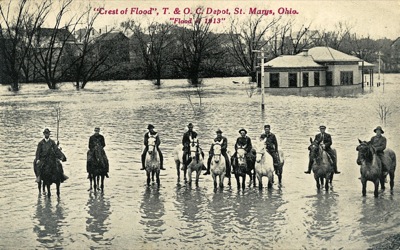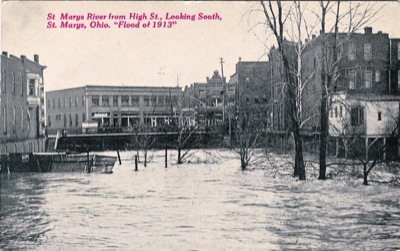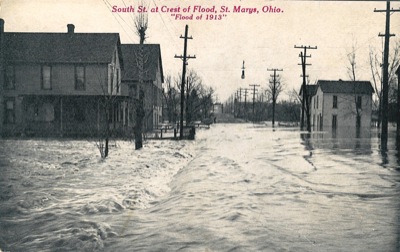Monday, April 1st, 2013
A flood to remember
100 years ago rain, river waters engulfed St. Marys
By Amy Kronenberger

Photo by Amy Kronenberger/The Daily Standard
Auglaize County Historical Society Administrator Rachel Barber discusses the 100th anniversary exhibit of The Great Flood of 1913 at the Auglaize County District Public Library in Wapakoneta.
ST. MARYS - This week 100 years ago, residents were cleaning up from the worst recorded flood in Ohio history.
About 10 inches of rain fell over five days in late March 1913. Water swelled over the banks of the Miami-Erie Canal, St. Marys River and Auglaize River, and engulfed much of St. Marys and Wapakoneta.
To commemorate the anniversary of the Great Flood of 1913, the Auglaize County Historical Society has set up exhibits at St. Marys Community Library and at the Auglaize County District Public Library in Wapakoneta. The displays opened today and will remain until the end of the month.
Society administrator Rachel Barber said of the more than 420 people killed in the flood, none were in Auglaize County. Most fatalities occurred in Dayton, the area hardest hit by rain, with 123. Hamilton recorded 100 deaths, Troy 44 and Piqua 16.
Water from the Auglaize River filled downtown Wapakoneta and flooded neighborhoods as far away as Pearl Street.
One of the photographs in the exhibit shows Wapakoneta residents being rescued in a rowboat named the Bonnie Louise. The boat was named after the grandmother of former resident Louise Kattman, Barber said.
Kattman shared her memory of the flood in the book "A Celebration in History: Auglaize County Since 1900 in the Words of its People." The book was compiled by the county's sesquicentennial committee for the celebration in 1998.
"I forget who the fellow was that borrowed our boat," Kattman said in the book. "They used that to row into the homes along Auglaize Street to get people out of the second floor. It was terrible."
In St. Marys, the floodwaters from the canal and the St. Marys River inundated downtown and beyond, leaving many residents stranded, Barber said.
"St. Marys was even more impacted because of the canal," she said. "The flood was the official death of the canal."
Officials in some parts of the state used dynamite to open up canal locks to alleviate flooding, according to the Ohio Historical Society's Ohio History Central.
"By the early 20th century, few canals were still in operation in Ohio, but the destruction of the locks ensured the permanent end to canal transportation," the encyclopedia says.
Miami and Erie Canal Corridor Association Director Neal Brady said seven locks were dynamited in the Akron area. He has no records of any locks along the Miami-Erie Canal being blown apart.
"In this part of the state, the water overwhelmed so much, I don't think the locks could be found. It came on that quick," he said.
In 1914, Gov. James M. Cox signed into law the Vonderheide Act, also known as the Ohio Conservancy Law, giving the state the authority to establish watershed districts and collect taxes to make improvements.
"Although the Vonderheide Act was challenged both in state and federal supreme courts, the law was upheld. In 1915, the Miami Conservancy District was created in response to the Vonderheide Act, the first major watershed district in the nation," Ohio History Central says.
For the anniversary exhibit, Barber received about six items and many photos, mostly from the collection of professional photographer Louis Helpling, who documented the flood in Auglaize County.
The Heritage Trails Park District and MECCA will host a presentation about the flood's impact on the canal at 2 p.m. Sunday at the Lockkeepers House in New Bremen. Featured speaker will be Dave Newhardt, editor of the Canal Society of Ohio newsletter. The presentation is free and open to the public.
Memories from 1913 flood:
Below are excerpts from the book "A Celebration in History: Auglaize County Since 1900 in the Words of its People" produced for the Auglaize County sesquicentennial in 1998.
Mom says the water at our place (in Egypt) came up to the foundation of the house ... In the spring, they all had pigs but none lived ... There was such deep water between the barn and the house that Pop could not go to the barn. He would jump on (the farm hand's) back and then they would go to the barn and feed.
- Veronica Kuether
During the flood, there was a rumor that the east bank of Lake St. Marys was bursting. I know my father took a horse and buggy and drove over there for whatever he could do. But the rumor was false.
- Ferd Meckstroth
The boys in the neighborhood, they wanted to see the flood (in Dayton). So Henry Lammers drove their car ... When they came back, they had a set of tires worn out.
- Silas Lammers
I was a Boy Scout. We had to go all over town (New Bremen) and collect anything that the people wanted to give ... I was 15 years old; we could do a lot. I guess (what we collected) went mostly to Dayton.
- Harry Ludeka

Submitted Photo
Men on horseback show the depth of the floodwaters at the T. & O.C. railroad depot in downtown St. Marys. This photograph along with many others is on display at the St. Marys Community Public Library starting today.

Submitted Photo
Photographers had their cameras ready to capture history as floodwaters from the canal and St. Marys River spilled their banks. The Great Flood of 1913 engulfed most of downtown St. Marys after 10 inches of rain fell over five days.

Submitted Photo
Photographers had their cameras ready to capture history as floodwaters from the canal and St. Marys River spilled their banks. The Great Flood of 1913 engulfed most of downtown St. Marys after 10 inches of rain fell over five days.


